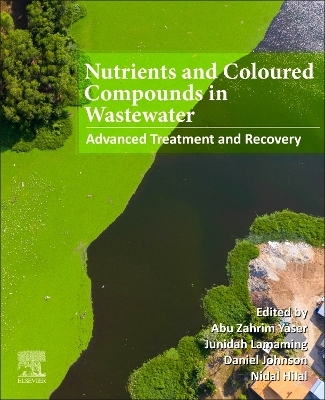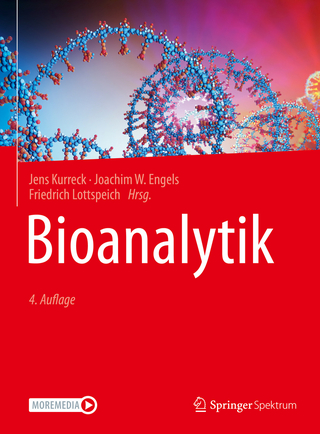
Nutrients and Colored Compounds in Wastewater
Elsevier - Health Sciences Division (Verlag)
978-0-443-21701-2 (ISBN)
- Noch nicht erschienen (ca. Januar 2025)
- Versandkostenfrei innerhalb Deutschlands
- Auch auf Rechnung
- Verfügbarkeit in der Filiale vor Ort prüfen
- Artikel merken
Nutrients and Colored Compounds in Wastewater: Treatment and Recovery reviews and highlights recent advances in nutrients and colored compounds in terms of their treatments, recovery processes, advanced systems, and new materials. This book comprehensively covers topics in wastewater management including phytoremediation, phycoremediation, microbial fuel cell process, membrane hybrid system, membrane distillation, forward osmosis, adsorption, electrocatalytic, photocatalytic, and organic metal framework reaction. It provides a useful agenda to help take advantage of the latest research conducted in this rapidly advancing field of wastewater treatment enabling you to develop and commercialize your own products quickly and more successfully.
Dr. Abu Zahrim Yaser is an Associate Professor in Waste Processing Technology at the Faculty of Engineering, Universiti Malaysia Sabah, Malaysia. He is a member of Institutions of Chemical Engineers (United Kingdom), Board of Engineers (Malaysia), MyBIOGAS (Malaysia), and a visiting scientist at the University of Hull. He obtained his PhD from Swansea University (UK), MSc from Universiti Kebangsaan Malaysia (Malaysia) and BEng from University of Malaya (Malaysia). His research mainly focuses on waste processing technology. He has published 10 books, 20 book chapters, 47 journals and 50+ other publications. He was the Guest Editor for Environmental Science and Pollution Research special issue. He won several medals in innovation competition including gold medal at iENA 2018, Germany. His innovation entitled “UMS Organic Compost helps Sabah state to win “Best State Innovation Award at IGEM 2019. His invention, the Auto Turning Active Zone Yield Composter (Auto AZY) has been adopted by Tongod District Council, Sabah, for managing their organic waste. Besides that, he is actively involved as a reviewer for several journals. Elsevier (UK) has recognized him as among the Outstanding Reviewers for Journal of Environmental Chemical Engineering (2018). Dr. Junidah Lamaming is currently a postdoctoral researcher at Faculty of Engineering, Universiti Malaysia Sabah. She obtained her Ph.D. in 2016 in the field of nanocellulose and nanofiber science and technology from Universiti Sains Malaysia, Malaysia. In 2015, her PhD research was awarded as the Best Research by the university and won awards in the university publication category. In 2017, he was awarded with Outstanding reviewer by Carbohydrate Polymers, Elsevier United Kingdom. Her research interests include nanocellulose fiber and applications, polymer blends, reinforced/filled polymer composites, adsorbents, characterization and production of lignocellulose-based composites and fire retardants, bioadhesives and biopolymers using sustainable methods. Over the years, she has published more than 40 articles in a significant number of high impact journals, conference papers, chapter in books, and books in her related research areas. She also contributes her expertise and knowledge by reviewing more than 40 international and national publications. She is a member of Malaysia Board of Technologists (MBOT). Dr. Daniel Johnson is an Assistant Professor of Civil and Urban Engineering at NYU Abu Dhabi. His main research interests have been in the fields of membrane separation research, advanced water treatment, membrane surface characterisation, and colloid and interface science, all primarily within the context of improving wastewater treatment technology and processes. He has published over 60 articles and book chapters and has taught courses in environmental engineering, wastewater treatment, membrane technology and colloid engineering. Dr. Nidal Hilal is a Professor of Engineering and Director of NYU Abu Dhabi Water Research Center. He is a Chartered Engineer in the United Kingdom (CEng), a registered European Engineer (Euro Ing), an elected Fellow of both the Institution of Chemical Engineers (FIChemE), and the Learned Society of Wales (FLSW). He received his bachelor's degree in chemical engineering in 1981 followed by a master's degree in advanced chemical engineering from Swansea University in 1986. He received his PhD degree from Swansea University in 1988. In 2005 he was awarded a Senior Doctorate, Doctor of Science degree (DSc), from the University of Wales in recognition of an outstanding research contribution in the fields Water Processing including Desalination and Membrane Science and Technology. He was also awarded, by the Emir of Kuwait, the prestigious Kuwait Prize (Kuwait Medal) of Applied Science for the year 2005 and Menelaus Medal 2020, by the Learned Society of Wales, for excellence in engineering and technology. His research interests lie broadly in the identification of innovative and cost-effective solutions within the fields of nano-water, membrane technology, and water treatment, including desalination, colloid engineering and the nano-engineering applications of AFM. He has published 8 handbooks, 82 invited book chapters, and around 500 articles in the refereed scientific literature. He has chaired and delivered lectures at numerous international conferences and prestigious organizations around the world. Nidal sits on the editorial boards of a number of international journals, is an advisory board member of several multinational organizations, and has served on/consulted for industry, government departments, research councils, and universities on an international basis.
1. Introduction
2. Azolla as phytoremediation agent in agricultural wastewater
3. Fluctuation of salinity alters phytoremediation performance of lead by spirulina platensis
4. Nutritional and biochemical properties recovery from cocoa based wastewater industry
5. Struvite precipitation from wastewater for sustainable phosphorus fertilizer
6. Phosphorus recovery from different organic substrates using single and mixed anaerobic digestion
7. Review of membrane hybrid systems for nutrient recovery from wastewater
8. Plant nutrients recovery from agro-food wastewaters using microbial electrochemical technologies
9. Membrane technologies for nutrient recycling from a microbial fermentation effluent
10. Recovery of struvite and water via electrocharged forward osmosis
11. Recovery of Ammonia from Wastewater
12. Modified halloysite for ammonium ion removal
13. Adsorption of ammonium ion, chromium and Fe using oil palm empty fruit bunch fiber based SMC from volvariella volvacea cultivation
14. Biochar for resource recovery and pharmaceutical removal from human urine
15. Nutrient recovery and ammonia-water production by MF-vacuum evaporation treatment
16. Coloured compounds removal and nutrient recovery: How membrane technologies in water treatment can be a contributor
17. Recent developments of biochar in the recovery and removal of nutrients and dyes in wastewater treatment
18. Colour and nutrient removal using water treatment residuals
19. The activated carbon produced from bamboo biochar (dendrocalamus asper) and its application as methylene blue dye removal from wastewater
20. Potential application of biosurfactant in micellar-enhanced ultrafiltration for removal of toxic dyes from aqueous stream: Performance, membrane fouling, and prospects
21. Simultaneous degradation of anionic and cationic dyes using electro-catalytic and photo-catalytic from multi-component systems: A Review
22. Adsorptive and photocatalytic removal of coloured pollutants from wastewaters: A critical review
23. Optimization of exhaustion rate in dyeing for effluent recovery
24. Low energy electrochemical oxidation efficiently oxidizes for textile dye
25. Removal of synthetic dyes from aqueous environment using metal-organic frameworks
26. Separation of industrial polymer effluent using chemical coagulant and flocculation
27. Development of coagulant based on Sabah local fruit
28. Conclusions and future prospects
| Erscheint lt. Verlag | 1.1.2025 |
|---|---|
| Verlagsort | Philadelphia |
| Sprache | englisch |
| Maße | 191 x 235 mm |
| Themenwelt | Naturwissenschaften ► Biologie ► Mikrobiologie / Immunologie |
| Naturwissenschaften ► Chemie ► Technische Chemie | |
| Technik ► Umwelttechnik / Biotechnologie | |
| ISBN-10 | 0-443-21701-7 / 0443217017 |
| ISBN-13 | 978-0-443-21701-2 / 9780443217012 |
| Zustand | Neuware |
| Haben Sie eine Frage zum Produkt? |
aus dem Bereich


